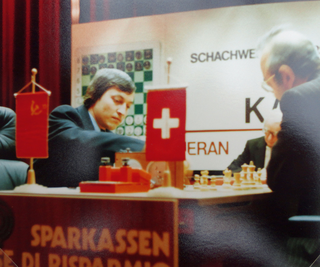
The World Chess Championship 2006 was a match between Classical World Chess Champion Vladimir Kramnik and FIDE World Chess Champion Veselin Topalov. The title of World Chess Champion had been split for 13 years. This match, played between September 23 and October 13, 2006, in Elista, Kalmykia, Russia, was to reunite the two World Chess Champion titles and produce an undisputed World Champion.

Deep Blue versus Garry Kasparov was a pair of six-game chess matches between then-world chess champion Garry Kasparov and an IBM supercomputer called Deep Blue. Kasparov won the first match, held in Philadelphia in 1996, by 4–2. Deep Blue won a 1997 rematch held in New York City by 3½–2½. The second match was the first defeat of a reigning world chess champion by a computer under tournament conditions, and was the subject of a documentary film, Game Over: Kasparov and the Machine.

The World Chess Championship 2008 was a best-of-twelve-games match between the incumbent World Chess Champion, Viswanathan Anand, and the previous World Champion, Vladimir Kramnik. Kramnik had been granted a match after not winning the World Chess Championship 2007 tournament.

The World Chess Championship 2010 match pitted the defending world champion, Viswanathan Anand, against challenger Veselin Topalov, for the title of World Chess Champion. The match took place in Sofia, Bulgaria from 24 April to 13 May 2010, with a prize fund of 2 million euros. Anand won the final game to win the match 6½–5½ and retain the title.

The World Chess Championship 1886 was the first official World Chess Championship match contested by Wilhelm Steinitz and Johannes Zukertort. The match took place in the United States from 11 January to 29 March, the first five games being played in New York City, the next four being played in St. Louis and the final eleven in New Orleans. The winner was the first player to achieve ten wins. Wilhelm Steinitz won the match 10–5, winning his tenth game in the twentieth game of the match. There were five draws.

The World Chess Championship 1889 was the second official World Chess Championship, and was between Wilhelm Steinitz and Mikhail Chigorin. It took place in Havana, Cuba. Steinitz defended his world title, and was the first of the two players to reach 10½. He won the match 10½-6½.

The third World Chess Championship was held in New York City from 9 December 1890 to 22 January 1891. Holder Wilhelm Steinitz narrowly defeated his Hungarian challenger, Isidor Gunsberg.
The Max Lange Attack is a chess opening that can arise from several different opening lines, including the Two Knights Defense, Petroff's Defense, Scotch Gambit, Bishop's Opening, Center Game, and Giuoco Piano. Two of the most commonly seen move orders are 1.e4 e5 2.Nf3 Nc6 3.Bc4 Nf6 4.d4 exd4 5.0-0 Bc5 6.e5, and 1.e4 e5 2.Nf3 Nc6 3.d4 exd4 4.Bc4 Bc5 5.0-0 Nf6 6.e5.

The 1935 World Chess Championship was played between challenger Max Euwe and title-holder Alexander Alekhine. It was played in various cities and towns in the Netherlands from October 3 to December 16. Euwe was the winner by overcoming a three-point deficit as late as the ninth game.

The 1978 World Chess Championship was played between Anatoly Karpov and Viktor Korchnoi in Baguio, Philippines, from July 18 to October 18, 1978. Karpov won, thereby retaining the title.

The 1981 World Chess Championship was played between Anatoly Karpov and Viktor Korchnoi in Merano, Italy from October 1 to November 19, 1981. Karpov won with six wins against two, with 10 draws. The two players had already played against each other in the World Chess Championship match 1978 in the Philippines, when Karpov also won.

The World Chess Championship 2014 was a match between the world champion Magnus Carlsen and challenger Viswanathan Anand, to determine the World Chess Champion. It was held from 7 to 25 November 2014, under the auspices of the World Chess Federation (FIDE) in Sochi, Russia.
The 1992 Fischer–Spassky match between former world chess champions Bobby Fischer and Boris Spassky was billed as a World Chess Championship, though it was an unofficial rematch of their 1972 World Championship match. Fischer won 10–5, with 15 draws.

The World Chess Championship 2016 was a chess match between the reigning world champion Magnus Carlsen and the challenger Sergey Karjakin to determine the World Chess Champion. Carlsen had been world champion since 2013, while Karjakin qualified as challenger by winning the 2016 Candidates Tournament. The best-of-12 match, organized by FIDE and its commercial partner Agon, was played in New York City between 10 and 30 November 2016.

The World Chess Championship 2018 was a match between the reigning world champion since 2013, Magnus Carlsen, and the challenger Fabiano Caruana to determine the World Chess Champion. The 12-game match, organised by FIDE and its commercial partner Agon, was played at The College in Holborn, London, between 9 and 28 November 2018. The games were broadcast on worldchess.com and by NRK.
The Berlin Defence is a chess opening that begins with the moves:
The 20th season of the Top Chess Engine Championship began on 1 December 2020 and ended on 1 February 2021. The defending champion was Stockfish, which defeated Leela Chess Zero in the previous season's superfinal. The season 20 superfinal was a rematch between the same two engines. Stockfish once again came out ahead, winning by 6 games.

The World Chess Championship 2023 was a chess match between Ian Nepomniachtchi and Ding Liren to determine the new World Chess Champion. The match took place in Astana, Kazakhstan, from 9 April to 30 April 2023, and was a best of 14 games, plus tiebreaks.













